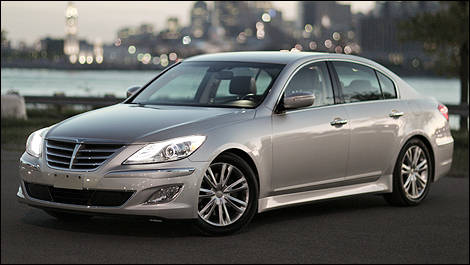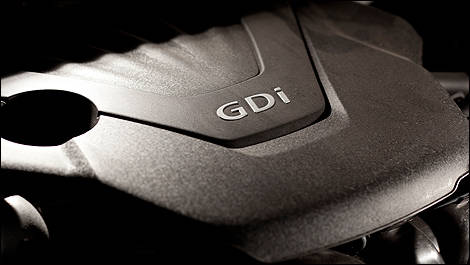You’ve got to wonder, like seriously, if Hyundai’s got anyone at BMW worried. The German automaker virtually pioneered the now-mandatory mentality of efficient performance, launching one powertrain technology after the other to create machines that were both gutsy and efficient. The Korean automaker, in many regards, is right on their tail.
No, not with new technology. That’s not quite how Hyundai plays ball. Instead, the rampaging Korean brand is taking a serious lead when it comes to adapting these advanced powertrain technologies for use in affordable models.
The days when dual-clutch transmissions and direct-injection engines were reserved mainly for high-end imports are over. Other automakers are rolling out the technologies too, but it’s Hyundai that’s largely implementing a full range of performance-enhancing, gas-saving systems into their lineup.
It culminates, largely, in the 2012 Genesis Sedan. Engineered to deliver power-per-litre bragging rights on a budget, the original had a 4.6L V8 engine with 375 horsepower. The premium brands upped the ante, and as promised, so did Hyundai.
The 2012 Genesis Sedan ships with a new 5.0L unit generating, call it, 429 horsepower. That’s more power per litre than the BMW M5’s last V8 engine made. Just saying.
And the extra punch comes, says Hyundai, without burning any extra fuel. Efficiency, right. This “more power, less fuel” mentality is going to snowball in a big way as Canadians demand thriftier cars.
Here’s a look at some of the key technologies and systems employed in the Genesis Sedan, and other new Hyundai models, that further the promise.
Direct injection: Placing the fuel injectors inside of the combustion chamber gives engineers more precise control over fuel delivery. By ensuring maximum energy extraction from every molecule of fuel, Hyundai’s high pressure “Gasoline Direct Injection” or GDI technology presents a win-win situation to drivers: more power output, less fuel burned.
Perhaps put on the map by Audi and BMW, Hyundai’s now even offering it as standard on the Accent, bringing the once-expensive system into a 13-grand car with a 1.6L engine. The same engine powers the new Veloster, a funky, urban-friendly hatch that calls the old Honda CRX to mind. Sonata and Genesis use GDI technology, too.
Dual-clutch transmission: This type of transmission acts as two manual gearboxes operating in parallel – with a separate clutch for each one. Google it for more details. Gears shift smoothly and instantly, with no interruption or pause in power delivery.
Hyundai’s EcoShift gearbox, which made its debut on the Veloster, also includes paddle shifters mounted to the steering wheel. This takes advantage of its sporty operation and lightning-fast gear changes.
In addition to fully automatic operation, this form of dual-clutch transmission offers the same performance and fuel mileage benefits as a regular manual. Transmissions like this one are more efficient than a conventional automatic, and typically lighter in weight.
Six-speeds all around: Once upon a time, the 6-speed transmission was saved only for the highest-performing vehicles on the road. Now, they’re everywhere. Accent? Elantra? Sonata? Six-speeds all around, in manual or automatic.
The more gears the merrier. More gears smooth out shifting with less of a ‘step’ between each one, better passing power, reduced noise levels and lower cruising revs.
Nutshell? More gears means better performance and better mileage. Six is the new standard. The Genesis Sedan has 8.
 |
| 2012 Hyundai Genesis Sedan 3.8L (Photo: Sébastien D'Amour/Auto123.com) |
No, not with new technology. That’s not quite how Hyundai plays ball. Instead, the rampaging Korean brand is taking a serious lead when it comes to adapting these advanced powertrain technologies for use in affordable models.
The days when dual-clutch transmissions and direct-injection engines were reserved mainly for high-end imports are over. Other automakers are rolling out the technologies too, but it’s Hyundai that’s largely implementing a full range of performance-enhancing, gas-saving systems into their lineup.
It culminates, largely, in the 2012 Genesis Sedan. Engineered to deliver power-per-litre bragging rights on a budget, the original had a 4.6L V8 engine with 375 horsepower. The premium brands upped the ante, and as promised, so did Hyundai.
The 2012 Genesis Sedan ships with a new 5.0L unit generating, call it, 429 horsepower. That’s more power per litre than the BMW M5’s last V8 engine made. Just saying.
And the extra punch comes, says Hyundai, without burning any extra fuel. Efficiency, right. This “more power, less fuel” mentality is going to snowball in a big way as Canadians demand thriftier cars.
Here’s a look at some of the key technologies and systems employed in the Genesis Sedan, and other new Hyundai models, that further the promise.
Direct injection: Placing the fuel injectors inside of the combustion chamber gives engineers more precise control over fuel delivery. By ensuring maximum energy extraction from every molecule of fuel, Hyundai’s high pressure “Gasoline Direct Injection” or GDI technology presents a win-win situation to drivers: more power output, less fuel burned.
Perhaps put on the map by Audi and BMW, Hyundai’s now even offering it as standard on the Accent, bringing the once-expensive system into a 13-grand car with a 1.6L engine. The same engine powers the new Veloster, a funky, urban-friendly hatch that calls the old Honda CRX to mind. Sonata and Genesis use GDI technology, too.
 |
| 2012 Hyundai Veloster (Photo: Sébastien D'Amour/Auto123.com) |
Dual-clutch transmission: This type of transmission acts as two manual gearboxes operating in parallel – with a separate clutch for each one. Google it for more details. Gears shift smoothly and instantly, with no interruption or pause in power delivery.
Hyundai’s EcoShift gearbox, which made its debut on the Veloster, also includes paddle shifters mounted to the steering wheel. This takes advantage of its sporty operation and lightning-fast gear changes.
In addition to fully automatic operation, this form of dual-clutch transmission offers the same performance and fuel mileage benefits as a regular manual. Transmissions like this one are more efficient than a conventional automatic, and typically lighter in weight.
Six-speeds all around: Once upon a time, the 6-speed transmission was saved only for the highest-performing vehicles on the road. Now, they’re everywhere. Accent? Elantra? Sonata? Six-speeds all around, in manual or automatic.
The more gears the merrier. More gears smooth out shifting with less of a ‘step’ between each one, better passing power, reduced noise levels and lower cruising revs.
Nutshell? More gears means better performance and better mileage. Six is the new standard. The Genesis Sedan has 8.


